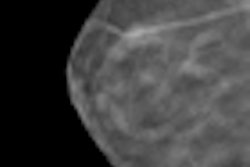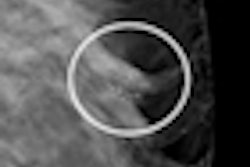CHICAGO - Digital breast tomosynthesis (DBT) shows promise in detecting and characterizing masses, particularly in women with dense breast tissue, researchers said in a Tuesday session at the RSNA 2011 meeting.
However, the technology does have some areas for growth, including the need for more clinical data on its recall specificity, appropriate dose, and use protocols, as well as the fact that increased clinical application will require training. And DBT reading times can be up to two times longer than those for digital mammography, according to some research.
Dr. Mark Helvie of the University of Michigan Health System gave a digital breast tomosynthesis overview to session attendees to set the stage for a series of studies that address both DBT's strengths and weaknesses.
"DBT does allow us to remove overlapping tissue artifacts, especially in dense breast tissue," he said. "It offers better screening sensitivity than full-field digital mammography [FFDM] alone, and can better characterize lesions in ensuing diagnostic workup. But there are trade-offs in terms of dose and performance. And since DBT, like digital mammography, is a morphologic technology, we don't get functional information [from the images]."
DBT comparable at finding noncalcified lesions
DBT has comparable sensitivity and specificity to standard diagnostic mammographic views for classifying noncalcified breast lesions, and it could replace the latter technology, according to researchers at the University of Pittsburgh who presented after Helvie.
Dr. Margarita Zuley and colleagues compared the diagnostic performance of DBT with additional digital mammography views meant to classify abnormal results found on initial mammography, ultrasound, clinical exam, or MRI.
Their study included 217 lesions found in 182 patients who had both diagnostic digital mammography and DBT. Of the 217 lesions, 182 were masses, 25 were asymmetries, and 10 were distortions.
"We confirmed our results with biopsy, an ultrasound showing an anechoic cyst, or one-year normal follow-up for benign stable asymmetries," Zuley told attendees.
Zuley's group identified 72 cancers and 145 benign lesions. Across all cases, the biopsy recommendation rate -- defined as BI-RADS 4 or 5 -- was 58% using DBT, compared with 61% using additional digital mammography views. DBT's specificity was 55% and sensitivity was 86%, whereas the specificity of additional digital mammography views was 52% and sensitivity was 88%.
Reading rates: On par with digital mammo?
During one of the session's presentations, Oslo University Hospital researchers discussed findings showing that even though interpretation time for DBT is longer than with FFDM, it's still acceptable for high-volume batch mode screening.
Dr. Per Skaane, PhD, and colleagues compared interpretation times for FFDM and DBT in a population-based mammography screening program. The study included women attending the Norwegian Breast Cancer Screening Program (age, 50 to 69) who were offered two-view DBT in addition to the standard two-view FFDM. The cohort consisted of 4,686 women who had FFDM; 3,488 of these also had DBT. Skaane's group measured interpretation time for all exams from when the case report form was presented to when the reader clicked the mouse to finish.
The mean interpretation time for FFDM was 49 seconds, while the mean reading time for DBT was 92 seconds, the team found. Of the 35 cancers detected, all had independent double reading for both FFDM and DBT. FFDM missed 10 cancers, and DBT missed one, for a relative increase in cancer detection of 36%.
Although it takes longer to interpret DBT data, it's still within an acceptable range, Skaane told session attendees. And the technology will only become more important.
"Will tomosynthesis for screening do away with double reading? Absolutely yes," he said.
Combining DBT and FFDM boosts cancer detection rate
In another presentation given during this session, Dr. Elizabeth Rafferty, from Massachusetts General Hospital, shared study results showing that FFDM with DBT increases the cancer detection rate in women with dense breasts.
Rafferty conducted the study along with Loren Niklason, PhD, to compare the clinical performance of FFDM alone and FFDM plus tomosynthesis in women with dense breast tissue.
"Prompt annual mammograms have shown the ability to reduce the breast cancer mortality rate by almost 50%," Rafferty told session attendees. "But we know that the modality's sensitivity decreases as breast density increases."
Rafferty and Niklason used a set of 293 cases that included 69 cancers, 74 benign biopsies, 50 recalled screening cases, and 100 negative screening cases with a BI-RADS density score of 3 or 4.
Adding DBT did increase the overall recall rate: For all cancer cases combined, recall rates for FFDM plus DBT were 9.7% higher than for FFDM alone (3.8% higher for calcification cases and 14.3% higher for noncalcification cases). For noncancer screening cases such as recalls and negatives, the recall rate for FFDM plus DBT was 23.3%, compared with 33.9% for FFDM alone, a reduction in the noncancer recall rate of 31%.
An audience member asked Rafferty if she thought DBT would be limited to use in women with dense breasts.
"I don't think so," she replied. "We've seen both clinically and in trials that DBT offers benefit for all women. But it does offer increased gains for women with dense breast tissue, and that's why we're starting our efforts there with what is still a limited resource."




















